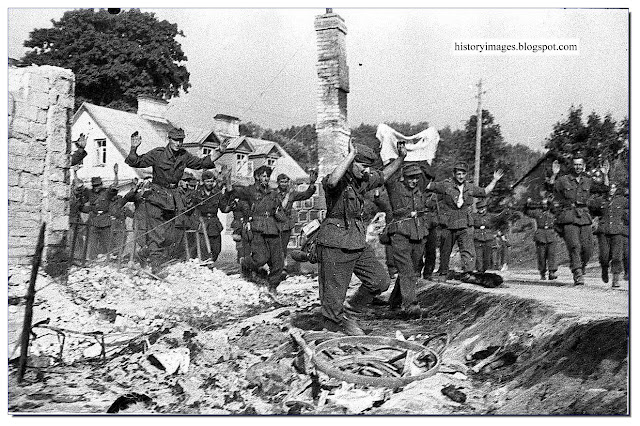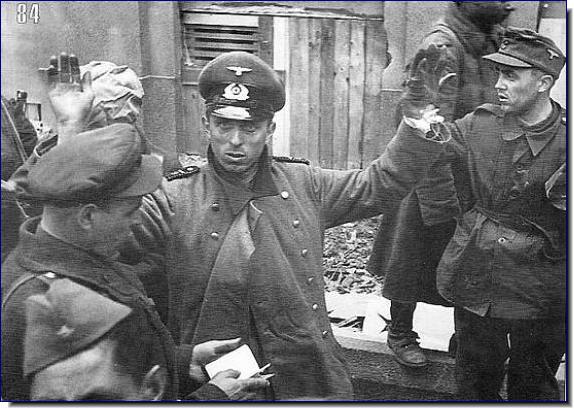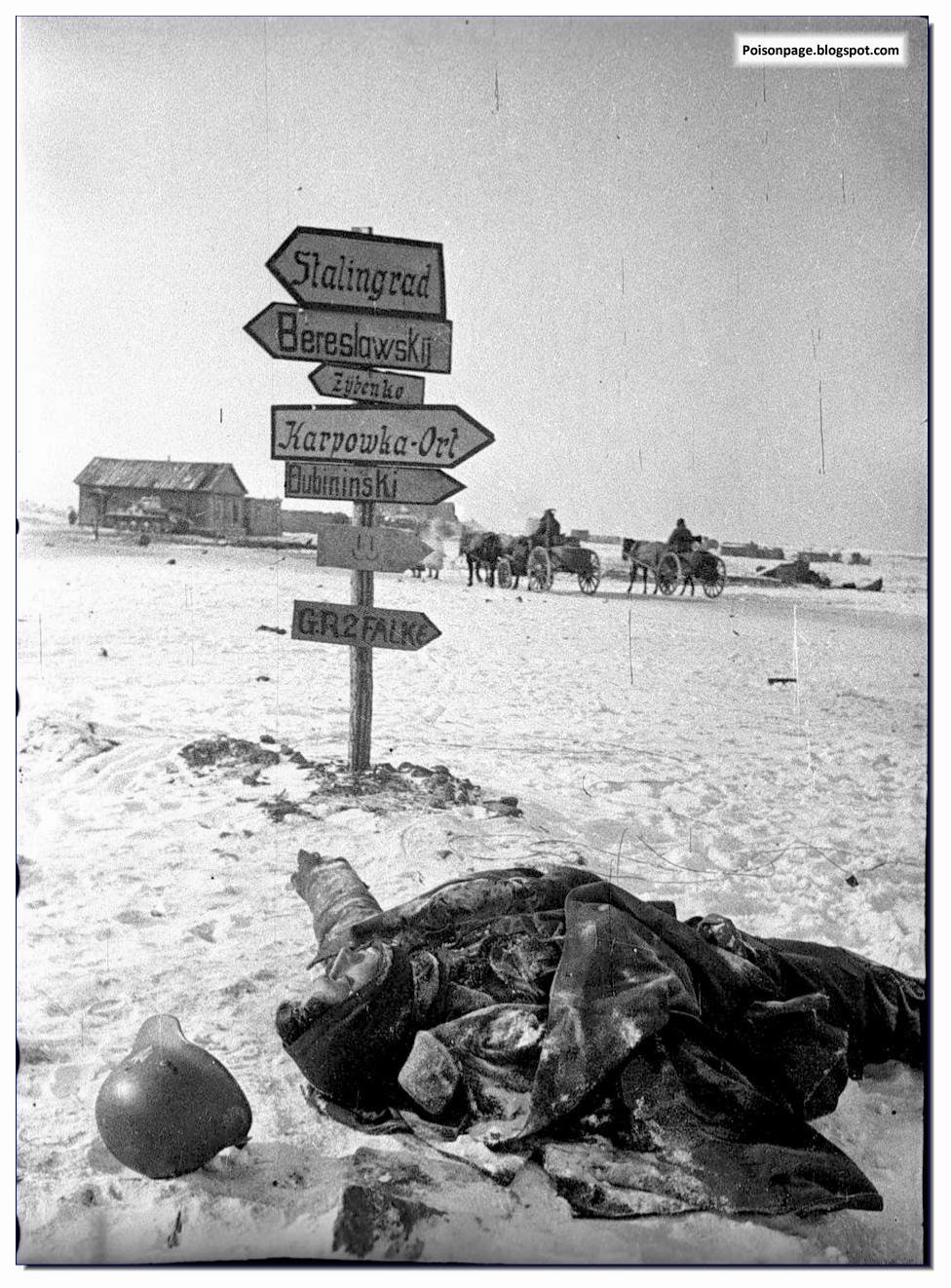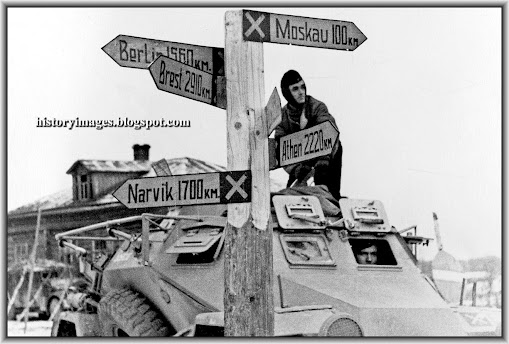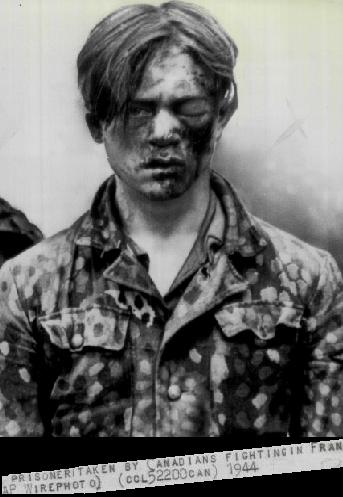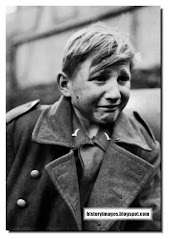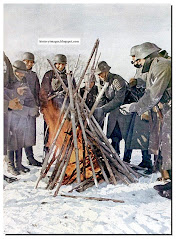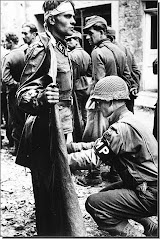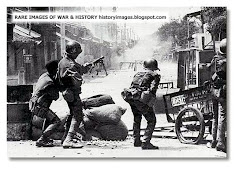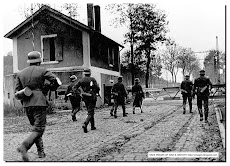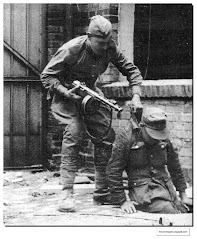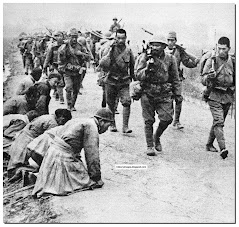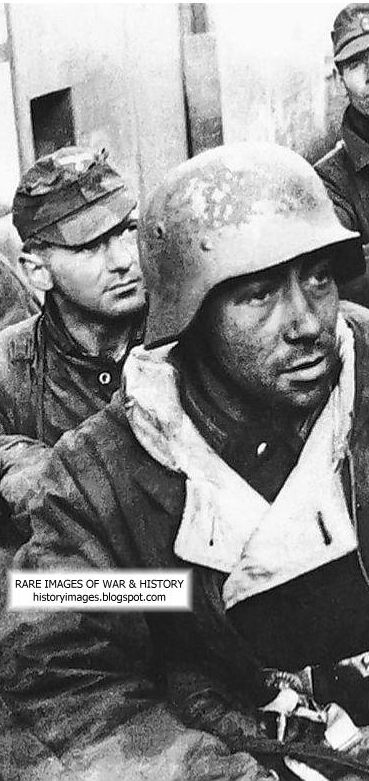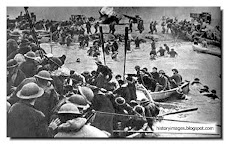Wounded German soldiers near Minsk, Belarus. 1944.
The years 1943-45 were years that saw a gradual obliteration of the German Army by the Red Army. The very fact that it took three years for the Russians to do it speaks volumes of the fighting quality of the German soldier.
Here it is. In images.
Soviet officers interrogate a captured German general.
Batov's 65th Army now fought their way into Babruysk street by street against stiff resistance from the German rearguard. Babruysk, in ruins and with much of its population killed during the German occupation, was liberated on June 29, 1944, the 383rd Infantry Division commencing withdrawal towards dawn: no further elements of Ninth Army would escape from east of the Berezina. The German breakout had allowed around 12,000 troops - mostly demoralised and without weapons - from the pocket east of Babruysk to get out, but the Soviets claimed 20,000 taken prisoner. A further 50,000 were dead: Soviet accounts speak of the area being carpeted with bodies and littered with abandonedmateriel. The Soviet writer, Vasily Grossman, entered Babruysk shortly after the end of the battle:
"Men are walking over German corpses. Corpses, hundreds and thousands of them, pave the road, lie in ditches, under the pines, in the green barley. In some places, vehicles have to drive over the corpses, so densely they lie upon the ground [...] A cauldron of death was boiling here, where the revenge was carried out"
Ninth Army had been decisively defeated, and the southern route to Minsk was open.
Destroyed German equipment in the Zhlobin highway. Belarus
Destroyed German tanks in Belarus
Russian warplanes attack a German convoy in Belarus, the summer of 1944.
Russian self-propelled guns SU-76M pass dead German soldiers. Belarus, Spring 1944.
Soviet soldiers in the battle on the streets of the city of Polotsk. July 1-4, 1944
Broken and abandoned German equipment in Bobruisk.
Red Army soldiers are fighting in the streets of Belgrade. Picture was taken at the height of the battle for Belgrade. In the foreground, a machine gunner with the DP-27. October 19, 1944.
A Belgrade resident looks at a dead German soldier. Brothers Jugovic Street (city center). 19-20 October 1944. In the battle of Belgrade itself the defending Germans, Italians, Chetniks lost 18,000 (killed) men. The loss of the Red Army - about 900 men, People's Liberation Army of Yugoslavia lost (though they actually were in the second tier) - about 2,200 men.
A Dead German soldier on the road in a suburb of Belgrade Topchidere. October 16, 1944.
Soviet tanks shot this German armored convoy to pieces in Belgrade. In the foreground - the Italian ACS Semovente L6/40 da 47/32, in the background of the tank, which served as her base: L6/40. October 1944.
Soviet soldiers with captured German Panzer 4 tanks in Belgrade. 1944.
A destroyed German self-propelled gun StuG III on the Boulevard of Liberation in Belgrade. Picture taken on October 18, 1944 - at the height of the battle for the city. However, the street is full of curious civilians, including children. In the distance one can see the dome of the Cathedral of St. Mark.
German soldiers under cover of a Tiger tank from the 502th battalion of heavy tanks at Narva, Estonia. February 1944.
Estonians in the Red Army pose against a German ACS
A column of German prisoners of war held near the railway station in Riga. In 1944. Some of them are smiling. Glad that the agony is over?
German soldiers pass by an immobilised Soviet IS-2 tank, during the fighting in Jelgava (Mitau) central Latvia. In 1944.
German soldiers surrender in Vilnius. July 11, 1944.
German snipers clean weapons and equipment in between battles. Romania, summer 1944. These guys are doing their job despite the fact that they knew the end was near.
Destroyed German military hardware lies strewn in Znojmo in Czechoslovakia. 1945
German tank destroyer Jagdpanzer 38, Hetzer lies abandoned in Prague. May 1945.
The Germans were retreating from Czechoslovakia. Here they are seen leaving for Hrushky, a small Czech town. April 1945.
A German Stug 3 stands forlorn on the streets of Prague. 1945. The German soldiers were gone. They were dead or had retreated.
German military equipment lie broken in Znojmo, Czechoslovakia. May 1945. The Russians had given a hammering.
Soviet troops with Hungarian POW on Debozy Street, Budapest. January 1945
A dead German Waffen SS soldier on the street in Budapest. February 1945
A column of wrecked German armored cars and personnel carriers in Budapest
DFS-230 glider sergeant Filiusa George (Georg Filius), crashed into a building number 35 or 37 (according to different sources), Attila the street while trying to land on the Bloody Meadow in Budapest on February 4, 1945. Gliders were used to give ammunition to the soldiers fighting there. The pilot died in the crash.
These Germans in a Sonderkraftfahrzeug 251are still fighting on. Fighting Soviet troops in Hungary. January 1945
German soldiers surrender in Budapest, Hungary. February, 1945
Russian troops in Budapest
German POW are made to see the remains of the inmates of the Majdanek camp. Outskirts of the city of Lublin, Poland, 1944.
July 30, 1944. Poland. German troops firing at the advancing Red Army with a Pak 40 anti-tank gun.
German troops aboard a Sturmpanzer 43 play with a monkey in Warsaw, Poland. August-September 1944
Grenadiers of the German SS Panzer Division "Totenkopf" change position during the battle of Warsaw, running past a burning Soviet T-34 tank. August 18, 1944.
A dead German soldier lies in Vienna. April 1945
Austrian children play near the remains of a heavy Panzer 4 tank outside Vienna
This family of a Nazi official killed itself rather than fall into Russian hands. Vienna, Austria. 1945. Soviet officers stand watching the bodies.
Soviet soldiers march down a street of Vienna.
Red Army soldiers are fighting in the streets of Belgrade. Picture was taken at the height of the battle for Belgrade. In the foreground, a machine gunner with the DP-27. October 19, 1944.
A Belgrade resident looks at a dead German soldier. Brothers Jugovic Street (city center). 19-20 October 1944. In the battle of Belgrade itself the defending Germans, Italians, Chetniks lost 18,000 (killed) men. The loss of the Red Army - about 900 men, People's Liberation Army of Yugoslavia lost (though they actually were in the second tier) - about 2,200 men.
A Dead German soldier on the road in a suburb of Belgrade Topchidere. October 16, 1944.
Soviet tanks shot this German armored convoy to pieces in Belgrade. In the foreground - the Italian ACS Semovente L6/40 da 47/32, in the background of the tank, which served as her base: L6/40. October 1944.
Soviet soldiers with captured German Panzer 4 tanks in Belgrade. 1944.
A destroyed German self-propelled gun StuG III on the Boulevard of Liberation in Belgrade. Picture taken on October 18, 1944 - at the height of the battle for the city. However, the street is full of curious civilians, including children. In the distance one can see the dome of the Cathedral of St. Mark.
German soldiers under cover of a Tiger tank from the 502th battalion of heavy tanks at Narva, Estonia. February 1944.
Estonians in the Red Army pose against a German ACS
A column of German prisoners of war held near the railway station in Riga. In 1944. Some of them are smiling. Glad that the agony is over?
German soldiers pass by an immobilised Soviet IS-2 tank, during the fighting in Jelgava (Mitau) central Latvia. In 1944.
German soldiers surrender in Vilnius. July 11, 1944.
German snipers clean weapons and equipment in between battles. Romania, summer 1944. These guys are doing their job despite the fact that they knew the end was near.
Destroyed German military hardware lies strewn in Znojmo in Czechoslovakia. 1945
German tank destroyer Jagdpanzer 38, Hetzer lies abandoned in Prague. May 1945.
The Germans were retreating from Czechoslovakia. Here they are seen leaving for Hrushky, a small Czech town. April 1945.
A German Stug 3 stands forlorn on the streets of Prague. 1945. The German soldiers were gone. They were dead or had retreated.
German military equipment lie broken in Znojmo, Czechoslovakia. May 1945. The Russians had given a hammering.
Soviet troops with Hungarian POW on Debozy Street, Budapest. January 1945
A dead German Waffen SS soldier on the street in Budapest. February 1945
A column of wrecked German armored cars and personnel carriers in Budapest
DFS-230 glider sergeant Filiusa George (Georg Filius), crashed into a building number 35 or 37 (according to different sources), Attila the street while trying to land on the Bloody Meadow in Budapest on February 4, 1945. Gliders were used to give ammunition to the soldiers fighting there. The pilot died in the crash.
These Germans in a Sonderkraftfahrzeug 251are still fighting on. Fighting Soviet troops in Hungary. January 1945
German soldiers surrender in Budapest, Hungary. February, 1945
Russian troops in Budapest
German POW are made to see the remains of the inmates of the Majdanek camp. Outskirts of the city of Lublin, Poland, 1944.
July 30, 1944. Poland. German troops firing at the advancing Red Army with a Pak 40 anti-tank gun.
German troops aboard a Sturmpanzer 43 play with a monkey in Warsaw, Poland. August-September 1944
Grenadiers of the German SS Panzer Division "Totenkopf" change position during the battle of Warsaw, running past a burning Soviet T-34 tank. August 18, 1944.
A dead German soldier lies in Vienna. April 1945
Austrian children play near the remains of a heavy Panzer 4 tank outside Vienna
This family of a Nazi official killed itself rather than fall into Russian hands. Vienna, Austria. 1945. Soviet officers stand watching the bodies.
Soviet soldiers march down a street of Vienna.


















